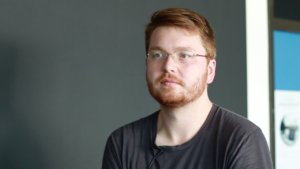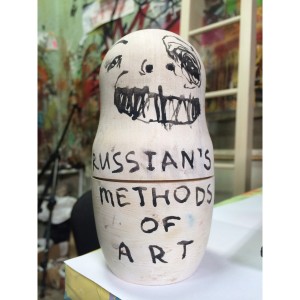MATERIAL
Our material, I think, I mean – I don’t know, if I had to be like poetic, I’d be like, it’s the network of people and it’s our, you know, like, it’s this community of people and shared ideas and thinks like that. I mean, it’s also our, like distribution channels as well, it’s part of the medium I think, of how we work and have always worked. And that like, how do you, you know, like, how do you reach people and finding methods, to reach people. It’s another big part. But in a practical way, we traffic in images, you know. Still images, moving images, headlines, taglines, text, you know, I mean, this is like – that’s like the more concrete stuff.
I guess, the medium is the images and the whatever. And the material is like the ideas, the kind of shared google docs and things like that. I mean, if you could see these docs, like the backend of DIS, it’s really like a really frantic place. I’ve just shared – just like constantly sharing hyperlinks, you know. So, we really live in that landscape of hyperlinks. Yes.
So, the material for a video – we’ll just take Obama Baroque, just randomly – that was a collection of collaborator hitters, really. I mean, we had like a brief encounter with Sean Monahan and I don’t know, how Gossip Girl came up, but we had this kind of like momentary like thought and then we’re like, you need to write that, we need to write so, like this is the story, we’re doing it kind of – we’re doing a series on the financial collapse and like Gossip Girl fits perfectly in, like that’s – and we had basically harassed him, you know, to write something for us. And then finally getting a script and then rewriting and that’s the process, you know, until we have a kind of voiceover. And then it’s about like, you know – actually I think we visually knew, what we wanted, before we knew like exactly, how the script was going to be told. But then as – you know, we’ve got like Sean Monahan, and then we have the voiceover artist, who sounds just like Gossip Girl from the film, we have Vaquera, a fashion collective, doing the costumes, and Walter Pearce who’s doing the casting for us, with his agency Midland, you know. And then we have And or Forever doing the sets for that and then you have, you know, a kind of go to like director of photography and cinematographer and got to like, you know, like a sound designer as well. So, I mean, it’s really like a film production, you know. I mean, it really really is, like when we’re doing something, it’s not even like the – it’s kind of like a bit of a bigger scale, than we don’t know, we have worked at that scale with so many people. But then you have the cast, you know, like Dese (Escobar), and like Bailey (Stiles), you know, starring and like acting, like never done that before. So, it’s a whole – it’s a whole enterprise, really, of people. And then there is like trying to get a free studio and equipment and, you know, just that whole – that’s the material. That – to create it. And then once you have the video – I mean that is the work. Sometimes it is hard for us to kind of like, I guess, except that, when showing that work, you need more, than just a video. Like, you know – I mean we have shown it just as a projected a couple times, but you do want to create a kind of ambience. So, then we work with like other designers to kind of create like posters and stuff like that. And then we take photos during the shoot, that can be edited later and come up with more taglines and, you know. So, it just kind of becomes this basket of material, that can be used. And they are used in like so many different ways in the end. Same image might go on a museum wall that will go as like a story on Instagram.
I mean, we’re not that invested in talking about contemporary art or critical theory like specifically. We’re obsessed with world politics, like who isn’t right now? It’s really hard. But we also don’t want to get – but we also want to go little deeper than that and, so on and so forth. So, I think the things that we’re looking for right now, are kind of – how do you say like – I think because, you know, as like a – like as a population, we’re really having a hard time imagining the time before now, we have a hard time imagining that anything could ever change, you know. So, we are like trying to just imagine another way. So, a lot of the kind of like authors and people who we’re reading are people who are speculating on different options, you know. So, like personally, I’m really into like economics and like kind of a new breed of economic theory. One that is not based on like the 1940th countering communism and totalitarianism, but one that actually accepts the twenty first century as a starting point instead of so old fashioned. So, like modern monetary theory is like one, that we’re really interested in. Kate Raworth – I think, that’s her name – who like kind of developed like doughnut economics. So, we’re kind of going down those routes a little bit more.
Well, humor is a great unifier, you know, for people. And I think, that’s why we often times like find something kind of tongue and cheek, to lean on. I mean, we have been called ironic for so long, but it’s not, like we’ve never seen ourselves as being ironic and we don’t think, it’s ironic, to pair, you know, a scholar and academic with like you know, game of thrones. Like, these things do exist in the same world, you know. So, why not in the same video, I don’t know.

















